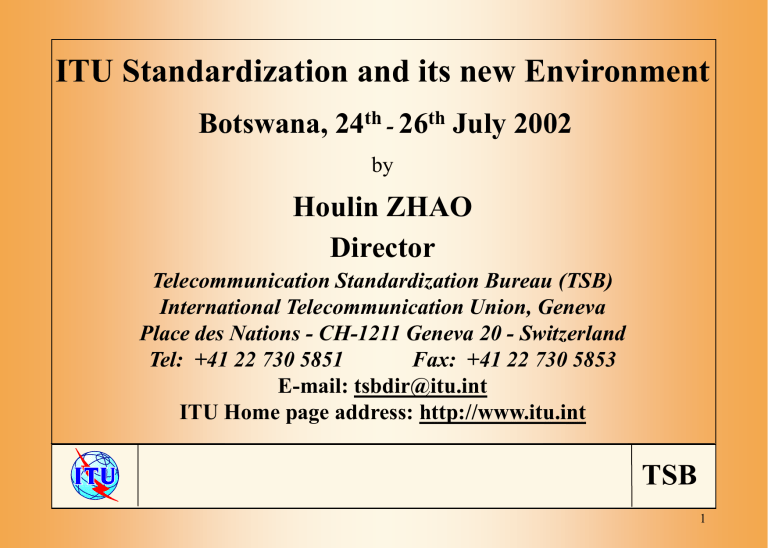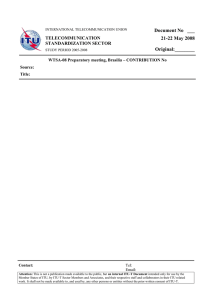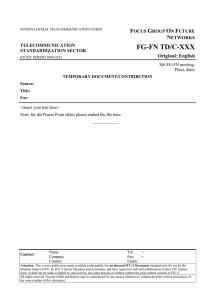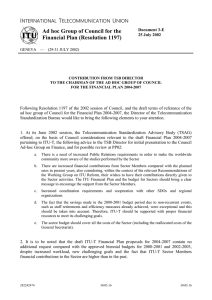ITU Standardization and its new Environment Botswana, 24 26 July 2002
advertisement

ITU Standardization and its new Environment Botswana, 24th - 26th July 2002 by Houlin ZHAO Director Telecommunication Standardization Bureau (TSB) International Telecommunication Union, Geneva Place des Nations - CH-1211 Geneva 20 - Switzerland Tel: +41 22 730 5851 Fax: +41 22 730 5853 E-mail: tsbdir@itu.int ITU Home page address: http://www.itu.int TSB 1 1837 1844 Invention of the first electric telegraph Samuel Morse sent his first public message over a telegraph Iine between Washington and Baltimore 1865 Foundation of the International Telegraph Union by twenty States 17 May with the adoption of the first Convention. First Telegraph Regulations. 1876 Alexander Graham Bell patents his invention of the telephone 1924 1925 1927 1932 Paris - Creation of CCIF (International Telephone Consultative Committee) Paris - Creation of CCIT (International Telegraph Consultative Committee) Washington - Creation of the CCIR (Intl. Radio Consultative Committee) Madrid - Plenipotentiary Conference. Telegraph Union changes name to International Telecommunication Union 1947 1956 1992 ITU becomes a Specialized Agency of the United Nations Geneva - CCIF and CCIT merged into CCITT (International Telegraph and Telephone Consultative Committee) Geneva - Plenipotentiary Conference. Creation of 3 Sectors: ITU-T replaces CCITT, ITU-R replaces IFRB, CCIR, and ITU-D replaces TCD ITU Landmarks TSB 2 Plenipotentiary Conference Council Radiocommunication Sector Telecommunication Standardization Sector Development Sector World/Regional Conferences Radiocommunication Assembly World Telecommunication Standardization Assembly (WTSA) World/Regional Conferences Radio Regulations Board Coordination Committee Study Groups Secretary-General Deputy Secretary-General Director General Secretariat Bureau Advisory Group Study Groups Director Advisory Group Bureau Structure of the ITU World Conferences on International Telecommunications Study Groups Director Advisory Group Bureau TSB 3 mainly financed by Governments work dominated by industry procedures very efficient, no longer slow seek effective cooperation with SDOs to share the work should be open to emerging technologies should be open to researchers / students try to keep its pre-eminent status Situation of ITU Standardization TSB 4 CCITT 1956 1960 1964 1968 1972 (International Telegraph and Telephone Consultative Committee): 1st Plenary Assembly 2nd Plenary Assembly Red Books 3rd Plenary Assembly Blue Books 4th Plenary Assembly White Books 5th Plenary Assembly Green Books 1976 1980 1984 1988 6th Plenary Assembly 7th Plenary Assembly 8th Plenary Assembly 9th Plenary Assembly Orange Books Yellow Books Red Books Blue Books ITU-T (International Telecommunication Union - Telecom. Standardization Sector): 1993 1st World Telecommunication Standardization Conference (WTSC-93), Helsinki 1996 2nd World Telecommunication Standardization Conference (WTSC-96), Geneva 2000 3rd World Telecommunication Standardization Assembly (WTSA-2000), Montreal CCITT and ITU-T TSB 5 "The functions of the Telecommunication Standardization Sector shall be, bearing in mind the particular concerns of the developing countries, to fulfill the purposes of the Union relating to telecommunication standardization, as stated in Article 1 of this Constitution, by studying technical, operating and tariff Questions and adopting Recommendations on them with a view to standardizing telecommunications on a worldwide basis" Functions of ITU-T TSB 6 WORLD TELECOMMUNICATION STANDARDIZATION ASSEMBLY TELECOMMUNICATION STANDARDIZATION ADVISORY GROUP STUDY GROUP - Workshop / forum - Focus Group - Joint Group - Project team STUDY GROUP WORKING PARTY STUDY GROUP WORKING PARTY WORKING PARTY R R R R R = RAPPORTEUR GROUP Organizational Structure of ITU-T TSB 7 Study Group 2: Operational aspects of service provision, networks and performance Study Group 3: Tariff and accounting principles including related telecommunications economic and policy issues Study Group 4: Telecommunication management, including TMN Study Group 5: Protection against electromagnetic environment effects Study Group 6: Outside plant Study Group 9: Integrated broadband cable networks and television and sound transmission Study Group 11: Signalling requirements and protocols ITU-T Study Groups and TSAG TSB 8 Study Group 12: End-to-end transmission performance of networks and terminals Study Group 13: Multi-protocol and IP-based networks and their internetworking Study Group 15: Optical and other transport networks Study Group 16: Multimedia services, systems and terminals Study Group 17: Data networks and telecommunication software SSG: IMT-2000 and Beyond TSAG: Telecommunication Standardization Advisory Group (Priorities: IP, Mobility, next generation, security, …) ITU-T Study Groups and TSAG TSB 9 4 weeks 3 months minimum maximum 1 month minimum 7 working days SG meeting Consultation period SG or WP meeting SG or WP determination Edited text available Chairman's request Text distributed Director's announcement SG decision Director's notification Director's request Deadline for Member States' replies Approval of new and revised Recommendations Sequence of events (TAP) TSB 10 (a) 3 weeks 4 weeks LC SG or WP Meeting Edited Text for LC Director’s Announcement and Posting for LC (b) Director’s Announcement and Posting (c) (a) (b) Comment Resolution Edited Text Available LC: AR: 3 weeks AR Director’s Announcement and Posting for AR SG Meeting (b) (a) Approved Director’s Notification Last Call Additional Review AAP Sequence of Events (extract from Rec. A.8) TSB 11 • • • • • • • • • Questions (projects) Contributions driven (normal contributions, delayed contributions, temporary documents) face-to-face meeting: - debate, determination, approval of reports, approval of Questions - SG/WP meetings: decision making; Rapporteur meetings: develop texts Decision = consensus, unanimous agreements Recommendations (Amendments, Corrigenda, supplements) draft Recommendations, determined draft Recommendations approved Recommendations, pre-published Recommendations, published Recommendations Implementor’s Guides Meeting reports Electronic submissions, web consultations, email, ftp Paperless meeting – LAN/Wireless – LAN connections in meeting rooms Working methods TSB 12 Series A Organization of the work of the ITU-T Series B Means of expression: definitions, symbols, classification Series C General telecommunication statistics Series D General tariff principles Series E Overall network operation, telephone service, service operation and human factors Series F Non-telephone telecommunication services Series G Transmission systems and media, digital systems and networks Series H Audiovisual and multimedia systems Series I Integrated services digital network ITU-T Recommendations Series (1) TSB 13 Series J Transmission of television, sound programme and other multimedia signals Series K Protection against interference Series L Construction, installation and protection of cables and other elements of outside plant Series M TMN and network maintenance: international transmission systems, telephone circuits, telegraphy, facsimile and leased circuits Series N Maintenance: international sound programme and television transmission circuits Series O Specifications of measuring equipment Series P Telephone transmission quality, telephone installations, local line networks ITU-T Recommendations Series (2) TSB 14 Series Q Switching and signalling Series R Telegraph transmission Series S Telegraph services terminal equipment Series T Terminals for telematic services Series U Telegraph switching Series V Data communication over the telephone network Series X Data networks and open system communication Series Y Global information infrastructure and internet protocol aspects Series Z Languages and general software aspects for telecommunication systems ITU-T Recommendations Series (3) TSB 15 2001 - Best selling texts (in the order of sales number from 09/01): H.323 G.707/Y.1322 G.783 G.703 G.991.2 G.709 H.225.0 G.729 Q.763 Q.931 G.704 G.703 G.807/Y.1302 Q.763 Q.931 H.248 Annex K P.862 G.711 H.248 G.871/Y.1301 Some well-known ITU-T Recommendations: E.164 E.190 E.212 G.652 G.655 G.692 G.703 G.704 G.723 Annex A+disk G.723.1 G.729+Annex A+disk G.957 G.982 G.990-series (xDSL) H.225.0 H.245 H.248 H.263 H.323 I.365 I.432 I.731 J.112 J.117 M.3010 M.3100 M.3400 Q.931 Q.1700-series (IMT-2000) T.30 T.37 T.38 V.34 V.44 V.59 X.25 X.36 X.509 X.680-series (ASN.1) Y.1310 Y.1540 G.711 G.720 G.780-series (SDH) H.324 H.450 V.90 X.690 V.92 X.840-series G.826 Best Sellers of ITU-T Recommendations TSB 16 before Approval time Publication time Notes: 1. 1988 4 years 2-4 years 1989-1993 1993-1996 1997-2000 2001-2004 2 years 18 months 9 months 2-9 (exceptional case: 5 months) months 6-12 months 3-9 months 2 years 1-1.5 year Pre-published Recommendations, available on ITU-T Website, from a few days to four weeks after approval of the text. 2. Recs in force, pre-published, superseded/obsolete: available on ITU-T Website. 3. Forms of publication: paper, CD-ROM, electronic bookshop, online, etc. 4. FREE ONLINE ACCESS SINCE JANUARY 2001 (one free access per member, 3 free downloads for public) 5. “Approval time” counted between “determination/consent” and final approval Approval and publication time of Recommendations TSB 17 Three major items: - IP-related issues - IMT-2000 - Accounting rates Other items: - Multi-media, access networks (xDSL), optical transmission, security, numbering and addressing, inter-operabilities, IPR, etc. ITU-T's main work areas TSB 18 7 kHz band - wideband (G.722-series) 4 kHz band - analogue 64 kbit/s - PCM, G.711, 1972 32 kbit/s - ADPCM, G.721, 1984 16 kbit/s - G.728, 1992 8 kbit/s - G.729, 1996 4 kbit/s - G.4kbps ITU-T’s work on voice coding TSB 19 Classic facsimile (G3, G4) T.4, T.6 B/W still pictures (JBIG) T.82, T.83 Cont. tone colour (JPEG) T.81 (JPEG-LS) T.86 (JPEG-2000) T.800 (lossless) ITU-T’s work on still picture coding TSB 20 H.261 - video coding at n x 64 kbit/s H.262 - generic video and audio coding H.263 - video coding for low bit rates H.26L - in progress (vs. MPEG-4) - improved multimedia video coding ITU-T’s work on moving picture coding TSB 21 622 Mbit/s OPTICAL ACCESS 50 Mbit/s VDSL 25 Mbit/s 8 Mbit/s HDSL/ ADSL 2 Mbit/s 640 kbit/s ISDN Analog modems 128 kbit/s 9.6 kbit/s 56.6 kbit/s 28.8 kbit/s 1989 Year 1997 Access network 2000 TSB 22 Fully optical networks Increased bit rates (up to 40 Gbit/s) Use of multi-wavelength techniques DWDM Use of optical amplifiers Interoperability and interconnection Submarine optically amplified DWDM Access networks for new high speed services ITU-T’s work on Optical networking TSB 23 E.164 … G.707 (SDH), G.709 (OTN), G.722 (7 kHz), G.728 (16 kbit/s), G.729 (8 kbit/s), G.99x (xDSL) … H.248 (gateway), H.323 (multimedia systems) … I.365 (FR), I.432 (B-ISDN), I.732 (ATM) … J.112 (Cable TV), J.16x + J.17x (IPCablecom) … M.3120 (CORBA for TMN) … Q.933 (DSS1), Q.1300 (TASC), Q.1930 (BICC), Q.27xx (B-ISDN), Q.29xx (DSS2) … T.37, T.38 (IPfax), T.12x (multimedia conference) … V.29 (9.6 K modem), V.34 (34 kbit/s), V.90/V.92 (56 kbit/s) … X.25, X.75, X.76 (FR), X.85 (IP over SDH), X.86 (Ethernet over LAPS), X.121, X.4xx (MHS), X.5xx (Directory), particularly X.509, X.68x/X.69x (ASN.1), X.8xx (security), X.9xx (ODP) … Y-series: dedicated to IP and GII Z.100 (SDL), Z.14x (TTCN), Z.3xx (MM languages) … … ITU-T’s products for IP-networks TSB 24 Specified IMT-2000 systems and its spectrums Interworking functions to be used with existing and evolving IMT-2000 systems Convergence of fixed and existing IMT-2000 systems New Generation of mobile systems ITU-T’s mobile communications TSB 25 Quality of Service (QoS) Numbering and routing Security Tariffs and Accounting rates Interworking Ensuring global interoperability TSB 26 01/2000 12/2001 difference Administrations 189 189 - ROAs 161 179 + 18 SIOs 189 234 + 45 Associates - 30 + 30 Others 40 39 -1 (Others: such as ISO, IEC, ISOC/IETF, INTELSAT, INMARSAT, EUTELSAT, ETSI, CEPT…) ITU-T Members TSB 27 ROAs (87/1783) Administrations (96/2208) SIOs (167/1875) U.S.A. 342 NTT 188 Lucent 166+58 + China 232 FT 184 Ericsson 147+5+ Germany 187 BT 148 Siemens 136+17+ France 106 DT 134 Nortel 91+51+ Russia 99 ATT 77 Alcatel 35+23+40+18+ U.K. 95 KDDI 69 CSELT 69 Canada 63 Telecom Italia 65 NEC 47 Japan 63 Swisscom 65 Nokia 46 India 62 KT 59 Fujitsu 42 Ukraine 58 Telenor 58 Telecordia 36 Italy 56 Royal KPN 58 Motorola 27+8 Syria 53 Telia 46 OKI 32 Korea 50 Telekom Austria 37 ETRI 32 Total: 1466 (66%) Total: 1188 (67%) Total: 1126 (60%) (Note – Cisco: 13) Top Members participation (07/98-08/00) TSB 28 - ITU-T work is shared by Governments and Industry Members (service providers and telecom equipment vendors) - Individual Industry Memberships in ITU Sectors - 13 out of 14 Study Group Chairmen (including TSAG) appointed are from Sector Members - Classic telecom members (to attract new IT Members) - Director’s Informal Consultation meeting (with Industries) known as “Martigny meetings”, twice: Feb. 2000 and Feb. 2001 - Key point of ITU Reform: Industry Members’ rights and duties (partnership) Industry Members’ role TSB 29 Note Annual fee (US$) Budget SDO Membership fees (25,000,000 $) 40,000,000 SFr ITU-T Minimum mandatory Other optional ½ unit (31,500 SFr) 20,000 20,275,000 $ (21,909,000 Euros) ETSI Mandatory according to turnover 45 units (5,000 Euros/unit) 211,050 IETF Depending on participation 350 $/500 $ per meeting per person, 3 meetings per year 1050/1500 x ? Mandatory $ 42,000 / $ 18, 000 / $ 10,000 standards free 42,000 Through national members Shared by national members (five big members pay 9% of the budget) (individual company up to 50,000) 1,200,000 $ ECMA (18,300,000 $) 29,305,000 SFr ISO (11,900,000 $) 19,000,000 SFr IEC (4,456,200 Euros) 4,000,000 $ 3GPP Shared by 6 SDOs Average 500,000/SDO 1,840,000 $ 3GPP2 Shared by 5 SDOs Average 360,000/SDO W3C Mandatory IEEE Mandatory ATM Mandatory + meeting fees 50,000 $ / 5,000 $, standards free 50,000 5,000 $ 14,000/5,000/3,500/1,500, 14,000+1,000/1,100 x? $ 250/275 per meeting 4 meetings/year, standards free (Some SDOs receive secretariat support from their members; such expenditures are not counted in the budget.) 2,870,000 $ Company’s dues to SDOs (ITU-T Associates = US $ 6,000) TSB 30 Intergovernment NGOs ITU ISO, IEC ….. (ITU-T and ITU-R) Forums / Consortia / SDOs 1394TA AMI-C Bluetooth CommerceNet DHF ECMA EIDX FCIA GSM Assoc. IEEE IPv6 JECALS LONMARK MOPA OIF PHS MoU SCTE TINA-C UMTS Web 3D 3G.IP 3GPP AOEMA AOW Cable Modems CBOP CommerceNet J Committee T1 DISA DOPG ECOM ECTF EMA EMF FCIA-J FIPA HNF Home API IETF IFIP IrDA ITS America JEDIC JEMA MCPC MDG.org MPLS Forum MSF OMG OSGi PICMG PKI SDL Forum SDR TM Forum TOG USBIF UWCC WfMC WIN Forum 3GPP2 ARIB CDG COS DSL Forum EDIFICE ERTICO FRF HomePNA IFSA ITS UK JICSAP MITF MWIF PCCA POF SSIPG TSC W3C WLIF AIM ATM Forum CIF CPR ECE EDS ETSI FS-VDSL HRFWG IMTC JAVA JIMM MMCF OASIS PCISIG Salutation STA TTA WAP XTP Forum AMF BINTERMS CII CTFJ ECHONET EEMA EWOS FSAN IDB Forum IMWA JCTEA JMF Mobile Web ODVA PCMCIA SCF TIA TTC WDF ……… ITU positioning TSB 31 • ISO, IEC, ISO/IEC JTC 1 cooperation since the 1970s; common texts since 1992 WTSA-2000 Resolution 7, Recommendation A.23 Joint President Cooperation Group (JPCG) World Standards Cooperation (WSC) • IETF ITU-T Member since 1995 MoU PSO, July 1999; provide secretarial support to PSO, since 08/01 Joint management team meetings in 11/99 and 08/01; ENUM, H.248, T.37 … • ETSI ITU-T Member since early 1990s MoU cooperation in June 2000 • ISO, IEC, UN/ECE MoU on e-business in March 2000 • GSC (Global Standards Collaboration): Since March 1994 TTA, TTC, ARIB, ETSI, T1, TIA, TSACC, ACIF, ITU ITU-T coordination with SDOs TSB 32 ITU-T already defined processes for working with other organizations, and TSAG enhanced these to include working with IETF Guidelines were prepared for the SGs, including issues such as: - how to interact on ITU-T and IETF work items, including: * how ITU-T learns about existing and proposed new IETF work items * how IETF learns about ITU-T work items Representation, including: - IETF recognition at ITU-T meetings and vice-versa - communication contacts - mailing lists Document sharing, including: - drafting - the passing of documents between the Organizations - cross referencing Cooperation with IETF TSB 33 IETF protocol defined in RFC 2916 E.164 number can be used to look up a Uniform Resource Identifier (URI) - Web addresses most commonly known URIs Allows using E.164 number in context of combined PSTN & IP services (email, fax, SIP address, coordinates, other?) For example: +44 1206 762335 5.3.3.2.6.7.6.0.2.1.4.4.e164.TLD What is ENUM? TSB 34 Define and implement administrative procedures that coordinate delegations of E.164 numbering resources into the agreed DNS name servers Director of TSB, on behalf of Administrations, to control the implementation of ENUM under e164.arpa on a trial basis, while the registering is done by RIPE NCC ITU-T Responsibilities regarding ENUM TSB 35 ICANN Board of Directors, 3 from PSO Mr. Schink (Siemens) (ITU proposed candidate) ICANN Independent Review Panel (IRP) Nominating Committee 6 members: Mr. H. Zhao 3 years PSO (Director of TSB/ITU) Mr. T. Lee 2 years PSO Ms. C. Liu 3 years ASO Mr. J. K. Park 2 years ASO Mr. S. Hemphill 3 years DNSO Mr. O. Iteann 2 years DNSO GAC: Mr. R. Shaw and Mr. R. Hill ITU’s involvement in ICANN TSB 36 President of ICANN call for reform in February 2002 TSB Director conducted informal consultation with ITU Members in March/April TSB Director presents a paper to ICANN on its reform, offering to assist ICANN in certain areas ITU Council-2002 unanimously supported TSB Director’s initiative Many contacts between ITU-T and the outside partners concerned Hope for a successful ICANN reform ICANN Reform TSB 37 ITU-T Rec. A. 4: communication with forums and consortia ITU-T Rec. A. 5: referencing documents of other organizations in ITU-T Recommendations ITU-T Rec. A. 6: cooperation and exchange of information with SDOs Invitation to the Informal Forum Summit by the Director of TSB (December 3-4, 2001) ITU-T Cooperation with forums / consortia / SDOs TSB 38 A.4 A.5 A.6 ASN.1 Consortium ARIB (Association of Radio Industries and Businesses) ARIB ATM Forum ATM Forum Committee T1 DSL Forum Committee T1 CWTS ETIS (e-and telecommunication info. services) CWTS (China Wireless Telecommunication Standard Group) ECMA FRF (Frame Relay Forum) DSL Forum ETSI IMTC (Multimedia) ECMA Standardizing Information & Communication Systems IEEE IPDR Organization ETSI (European Telecommunications Standards Institute) JCTEA IPv6 Forum FRF NIST MPLS (Multi Protocol Label Switching) Forum IEEE (Institute of Electrical and Electronics Engineers) SCTE MSF (Multiservice Switching Forum) ISOC/IETF (Internet Society/Internet Engineering Task Force) TIA OASIS JCTEA (Japan Cable Television Engineering Association) TTA OIF (Optical Internetworking Forum) MPLS Forum TTC OMG (Object Management Group) NIST (National Institute of Standards and Technology) SDL Forum Society OASIS TM Forum (Tele Management Forum) OIF W3C (World Wide Web Consortium) OMG SCTE (Society of Cable Telecommunications Engineers) TIA (Telecommunications Industry Association) TM Forum TTA (Telecommunications Technology Association) TTC (Telecommunication Technology Committee) W3C Members for Rec. A.4, A.5 and A.6 relationship TSB 39 Cooperation on common subjects (liaisons, communications, mutual participation) Cooperation on workshops ITU-T provide draft texts and other documents to SDOs to post for public consultation ITU’s permission for SDOs to reproduce ITU-T texts More to be done for mutual benefit: market study, joint promotion, mutual reference, joint conferences, efficient coordination, common IPR policy, etc. “Informal Forum Summit”, Geneva, December 2001 Cooperation activities with SDOs (General) TSB 40 Some forums become A.4 members of ITU-T FS-VDSL Forum will become a Focus Group of ITU-T SG 16 Another Forum is considering to become a Focus Group of ITU-T Home page connections for ITU-T and Forums/Consortia ITU-T SG 16 management member be included in the Forum leadership New approaches… TO COOPERATE and WORK TOGETHER! New relationships between Forums/Consortia and ITU-T TSB 41 “Consensus: after WTSA-2000, the ITU-T procedures are now very streamlined and efficient so that any perception of slowness can no longer be attributed to the ITU-T methods…” “fully recognized that Sector Members have a significant leadership role in the ITU-T technical standardization activities…” “ITU-T is and should remain the unique worldwide venue for industry and governments to work together in developing, providing and promoting global consensus-based telecommunication requirements and standards for the Information Society” Industry Views on ITU-T Martigny, February 2001 TSB 42 WTSA-2000 preparatory meeting in Bamako, Mali, May 2000, jointly convened with BDT TAF meetings in Africa Region in 2000 ITU-T SG 12 meeting and workshop, Dakar, Senegal, 18-26 October 2001, supported by Senegal and ITU Area Office in Dakar TAF in Niamey, Niger, 23-27 April 2001, supported by Niger and ITU Regional Office ITU-T/TSB activities in Africa in 2000/2001 TSB 43 15 Sector Members from 9 countries (Côte d’Ivoire, Egypt, Kenya, Lesotho, Morocco, Nigeria, Senegal, South Africa, Togo) 4 regional organizations (ATU, COPTAC, LAS, URTNA) Increasing participation to SG activities, but still very low level (except for SG 3) Vice-Chairmen from Africa TSAG: Mr. A. Zourmba (Cameroon) SG 3: Mr. H. K. Hamani (Niger) SSG: Mr. P. F. Masambu (Uganda) Tariff Group for Africa (TAF): Chairman: Mr. M. Ndaro (Kenya) Vice-Chairmen: Mr. E. Elop (Cameroon) Mr. M. Traore (Mali) Mr. A. Akue-Kpakpo (Togo) African involvement with ITU-T TSB 44 Encourage more Sector Members (service providers) from Africa Region to participate in the technical SG activities Change mentality and policy under market-driven principles - market in Africa + Africans manage their own markets Africans have expertise From your contacts with top-level worldwide experts in the SG activities, to learn new trends of technology development, to defend your own interests, to gain confidence and to contribute to the global telecom standardization with African values. African participation in ITU-T TSB 45 Problems: limited financial resources, and no fellowships available for technical SGs Solution: Regional cooperation Sharing responsibility on subjects among countries and representing the regional/groups at the ITU-T meetings E-mail consultation: free ITU TIES accounts for ITU Members free electronic access to ITU Recommendations for ITU Members Contact TSB directly or through regional organizations ITU-T strengthens its presence in Africa by organizing meetings in Africa SEE YOU MORE AND MORE in ITU-T! ************ African participation in ITU-T TSB 46



